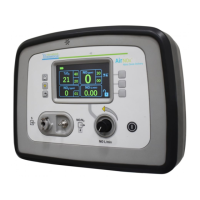
Do you have a question about the International Biomedical AeroNOx 2.0 and is the answer not in the manual?
| NO2 Range | 0-20 ppm |
|---|---|
| Response Time | <30 seconds |
| Operating Humidity | 15-95% RH, non-condensing |
| Power | 100-240 VAC, 50-60 Hz |
| Power Supply | 100-240V AC, 50/60Hz |
| Battery Life | 8 hours |
| Dimensions | 5 cm |
| Data Storage | Internal memory |
| Connectivity | USB |
| Display | LCD |
Overview of the AeroNOx 2.0 system, its components, and purpose.
Details the specific applications and intended patient population for the device.
Specifies medical conditions for which nitric oxide therapy is indicated.
Lists conditions under which inhaled nitric oxide therapy is not advised.
General safety guidelines for operating the AeroNOx 2.0 system.
Details the device's classification according to safety standards.
Highlights critical warnings, cautions, and notes for safe operation.
Explains various symbols used in the AeroNOx 2.0 documentation and on the device.
Lists and defines common abbreviations used in the manual.
Lists the components included in the AeroNOx 2.0 system package.
Step-by-step guide for setting up the AeroNOx 2.0 unit.
Instructions for purging the system to ensure gas purity and prevent contamination.
Identifies and describes the controls and indicators on the front of the device.
Identifies and describes the ports and features on the rear of the device.
Explains how to navigate between the main and calibration display screens.
Details the information shown on the main operational display screen.
Describes the options available in the calibration mode screen.
Explains the function and use of the universal power supply and charging.
Explains how the AeroNOx 2.0 system delivers and monitors nitric oxide.
Discusses how environmental factors can affect the device's performance.
Explains sensor response to pressure changes for NO and NO2.
Explains how pressure affects oxygen sensor readings.
How the flow meter display works and its limitations.
How various environmental factors affect operation.
Factors leading to degraded performance over time.
Instructions to complete before connecting the device to a patient.
General guidelines for connecting the AeroNOx 2.0 to a ventilator circuit.
Description of the INOstat Bagger as a backup NO delivery system.
Steps for performing a pre-use check of the INOstat Kit.
Detailed steps for using the INOstat Kit for NO delivery.
Describes methods for connecting to different breathing systems.
How to use the conventional sample/delivery kit with the device.
Diagram showing how to connect the device to an ICU ventilator circuit.
Step-by-step instructions for connecting to an ICU ventilator.
Diagram showing how to connect the device to a transport ventilator circuit.
Step-by-step instructions for connecting to a transport ventilator.
Diagram for connecting the device to a High Frequency TXP-2D Phasitron.
Step-by-step instructions for connecting to the Phasitron.
Diagram for connecting the device to the AeroNOx 2.0 Bagger.
Step-by-step instructions for connecting to the AeroNOx 2.0 Bagger.
An overview of the alarm system and its messages.
Information on alarm priorities, tones, and visual cues.
How to silence active alarms and the associated icon.
How to adjust alarm limits for monitored parameters.
Details the safety shut-off system and how to override it.
Lists system alarms with graphic representations and associated causes.
Formulas and examples for calculating NO flow rates.
Formula to estimate the diluted FiO2 after adding NO.
Explains the Oxygen Index calculation and interpretation.
How to calculate the remaining duration of a gas cylinder.
Information on gas supply, specifically for NO cylinders.
Provides guidance for resolving common issues with the device.
Procedure for daily low range (zero) calibration using room air.
Procedure for weekly high range calibration of the O2 sensor.
Procedure for weekly high range calibration of the NO sensor.
Procedure for weekly high range calibration of the NO2 sensor.
Schedule for routine user maintenance tasks.
Instructions and approved agents for cleaning the device.
Schedule and details for preventive maintenance tasks.
Process for returning the device for repair or service.
Step-by-step guide for replacing the gas sensors.
Instructions for replacing the internal rechargeable battery.
Procedure for replacing worn tips on delivery or backup regulators.
Lists available parts and accessories with their part numbers.
Describes methods for mounting the AeroNOx 2.0™™.
Details the dovetail mounting system and its limitations.
Details the VESA 75mm mounting standard for installation.
Guidelines for the proper disposal of accessories, sensors, and the device.
Lists ventilators validated for use with the AeroNOx 2.0™™.
Details the measurement ranges and accuracy of the device's sensors.
Specifications for the backup delivery regulator.
Specifications for the INOstat Bagger.
Specifications for the AeroNOx 2.0™™ delivery regulator.
Physical dimensions and weight of the device.
Operating and storage environmental parameters.
Electrical characteristics and standards compliance.
Performance specifications for the NO, NO2, and O2 sensors.
Information on electromagnetic compatibility and interference.
Critical performance aspects of the device for safety and operation.
Technical data sheet for the NO2 sensor.
Technical data sheet for the NO sensor.
Technical data sheet for the Oxygen sensor.
Tools for assessing user competency in operating the device.